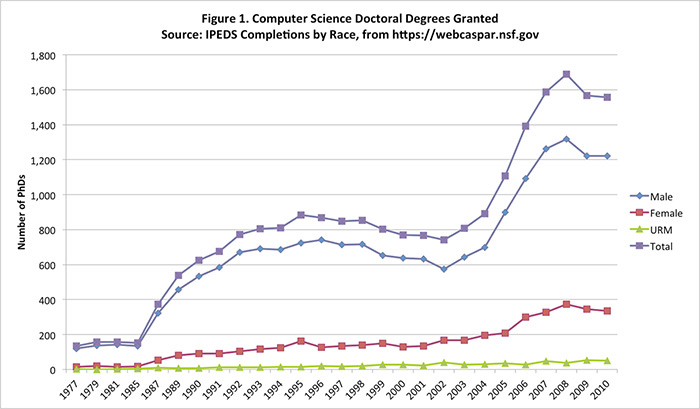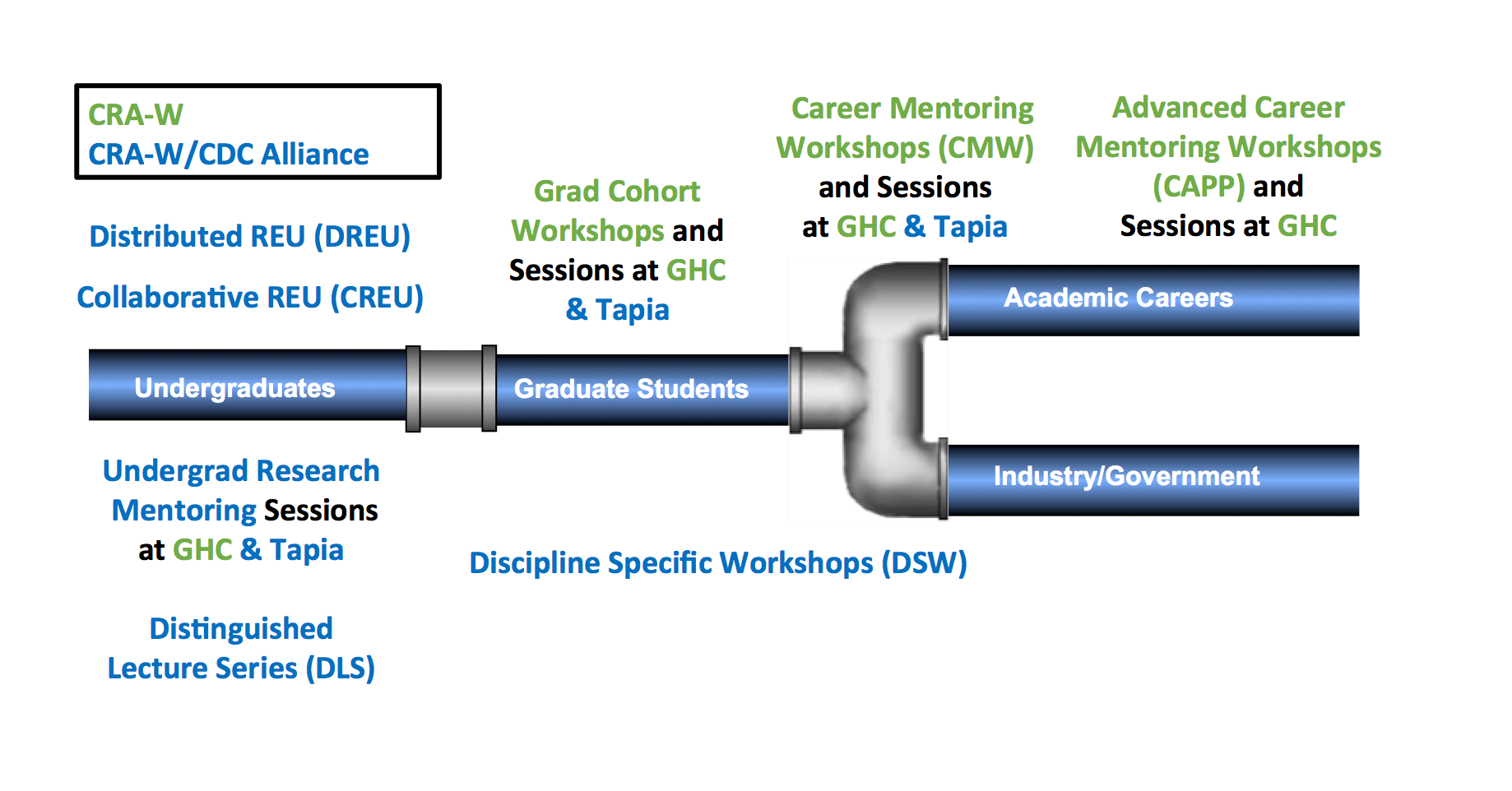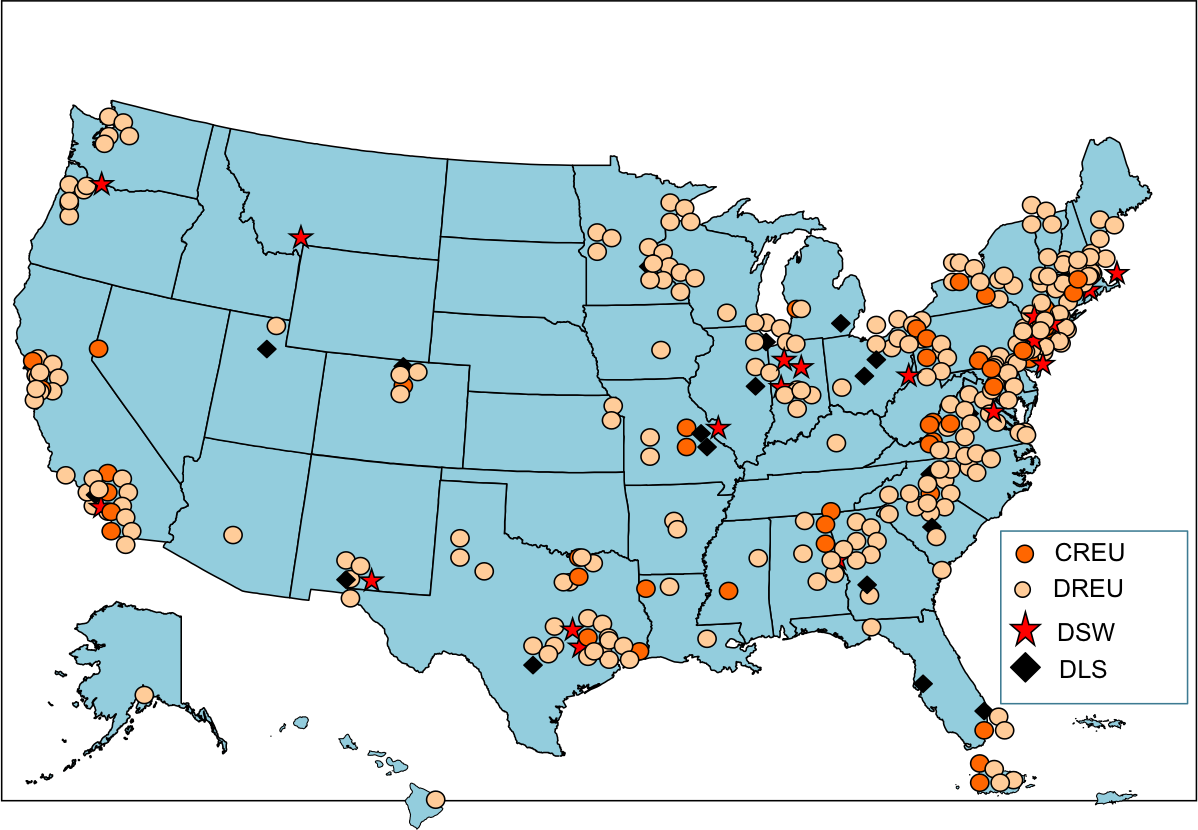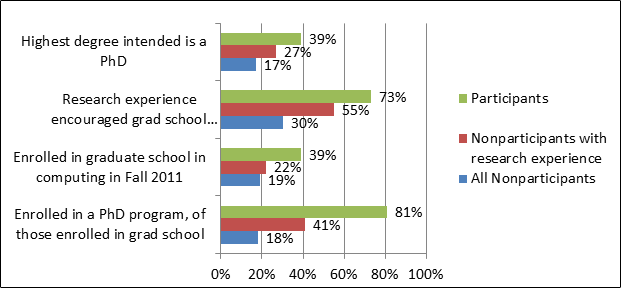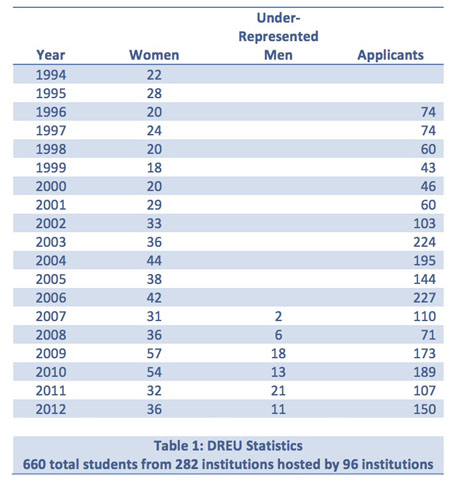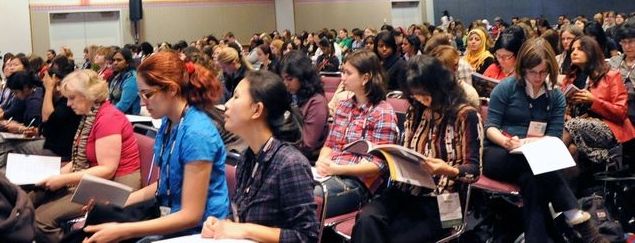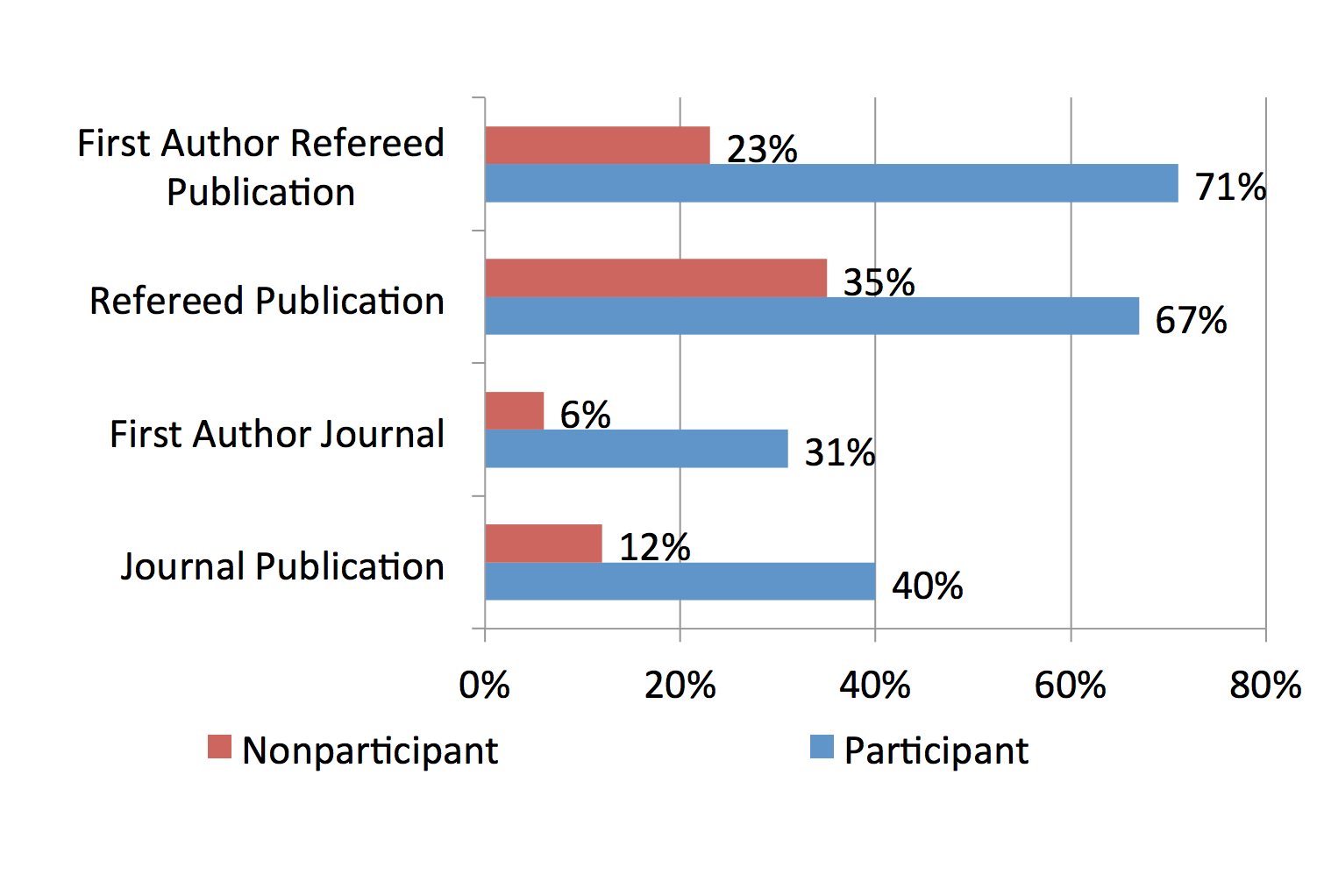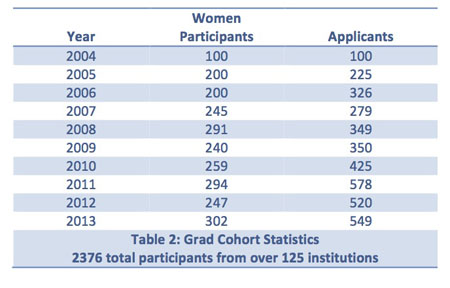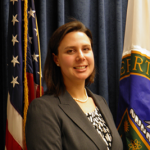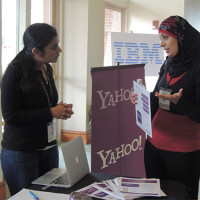Expanding the Pipeline: Diversity Drives Innovation
Lack of diversity in computing is an enormous opportunity cost for technical innovation. For example, recent studies published by NCWIT show patents with diverse authors are cited more and companies with a more diverse sales force have more income. Diversity drives innovation.
Even as demand for computing professionals grows, women and minorities are severely under-represented. For example, only 5.7% of the computer and mathematical workforce is Hispanic and 6.9% are African American according to the Bureau of Labor Statistics, whereas Hispanics and African Americans make up 30% of the US population (2010 US census). Under-representation at research institutions is worse than the profession as a whole. While 25% of computing professionals are women, only 13% of Full Professors are women. Figure 1 shows the lack of diversity in computing doctoral degrees. At major research universities, only 14% of undergraduate degree recipients were women. Minority representation is even bleaker. Blacks represent only 1.4% of all computing faculty. Only 10 women of color, out of 3000+, serve as faculty members at the top ranked 100 computing departments.
Severe under-representation of minorities and women (URM+W) at top ranked research institutions is self-perpetuating at best, as it compounds with pedigree bias (all faculty positions are disproportionally filled with graduates from top ranked institutions). At worst, under-representation may drive out more URM+W students because they lack role models, mentors, and peers who “look like them.”
Fig. 1: Computer Science Doctoral Degrees Granted
CRA-Women, the Computer Research Association’s Committee on the Status of Women in Computing Research (CRA-W), is working to change this dire situation by increasing the participation and success of women in computing. Founded in 1992, CRA-W has developed a suite of intervention programs to increase the success of women in computing research and education. These programs seek to produce academic and industry role models, mentors, and leaders that are diverse, because the diversity of research leadership drives student and workforce diversity. CRA-W partners with the Coalition to Diversify Computing (CDC), the Grace Hopper Celebration of Women in Computing Conference (GHC), Access Computing, and others to reach Under Represented Minorities and Women (URM+W), and people with disabilities. Figure 2 shows the range of CRA-W programs (some of which are collaborations with CDC) and how they span individual and group mentoring for undergraduates, graduate students, junior faculty members, and mid-career faculty members.
Fig. 2: CRA-W Programs for Women and Minorities
Fig. 3: CRA-W is Creating a National Community of Undergraduates, Graduate Students, and Faculty
CRA-W programs apply social science research that shows research experiences, career knowledge, communities, and mentoring encourage persistence in research careers. For each intervention program, CRA-W carefully selects and helps prepare successful senior women and URMs (as well as a few majority men) to provide research experiences, to communicate career knowledge, and to mentor students, young researchers, and mid-career researchers. These programs create a supportive national community (see Figure 3) of URM+W researchers within and across computing sub-disciplines, since these types of communities are usually not available at an individual’s home institutions.
Pedagogically, these experiences and communities serve to counter act cultural computing stereotypes, to create a diversity peer and mentor community, and to create positive research experiences. To discover if these programs work, the NSF Broadening Participation in Computing (BPC) program recently awarded CRA-W and CDC a grant for intervention programs and evaluation. This grant established the CRA Center for Evaluating the Research Pipeline (CERP), which is creating a national sample of computing students and professionals to study their experiences and compare their paths to intervention program participants.
Initial results are extremely positive (see the CERP Infographic in this CRN issue). Comparing other computing undergraduate and graduate students to CRA-W/CDC program participants reveals that CRA-W/CDC participants are more likely to persist in research, enroll in PhD programs, and publish compared to other students, even students with other research experiences.
Undergraduate programs include DREU, CREU, and a Distinguished Lecture Series. For example, the CRA-W/CDC Distributed Research Experiences for Undergraduates (DREU) program matches URM+W undergraduate students with URM+W faculty members with active research groups at another institution for a 10-week summer research experience proposed by the mentor. The DREU program defines milestones and expectations for students and advisors, including a web page and periodic reports from the mentor and mentee. Mentors discuss research careers with the mentees. DREU students participate in graduate student life and benefit from a close mentoring relationship with their advisors. The learning experience begins during the application process, which is modeled upon the graduate school application process. It includes letters of recommendation and a research statement. These activities generate uniform expectations and programmatic experiences for all participants, in spite of differing research projects.
Figure 4 shows that CRA-W/CDC undergraduate program participants continue on to graduate school in master’s and PhD programs at a higher rate than non-participants, adding URM+W to the computing research pipeline.
Fig. 4: CRA-W Undergraduate Program Participants Continue to Research Careers at a Higher Rate than Non-Participants
For graduate students, CRA-W offers Discipline Specific Workshops (with CDC), Career Mentoring Workshops (see Figure 5), and Grad Cohort. For example, Grad Cohort is a two-day workshop for first, second, and third year graduate students. A wide range of successful senior women researchers from academia and industry serve as role models. They offer practical advice and information on navigating graduate school. Example sessions include picking a thesis topic, writing papers, attending conferences, networking, internships, job hunting (it is never too early), publishing, interdisciplinary research, and managing your advisor. Figure 6 shows four accomplished speakers from Grad Cohort in 2012. Speakers describe personal insights on the challenges and rewards of their own careers. The workshop provides advising, mentoring, and peer networking opportunities.
Figure 5: Students Attending a CRA-W Career Mentoring Workshop at Grace Hopper
Figure 6: Four of the 21 CRA-W 2012 Grad Cohort Mentors. From left to right: Professor Lori Pollock, University of Delaware (CRA-W Board); Professor Nancy Amato, Texas A&M (CRA-W Board); Professor Tiffani Williams, Texas A&M (CDC Member); Professor Margaret Martonosi, Princeton (CRA-W Board, CRA Board).
Figure 7 shows that compared to their peer graduate students at the same career stage, continuing graduate students who attended CRA-W Grad Cohort are twice as likely to publish and three times more likely to be first author on a publication. Since publishing is a key step in a successful career, these milestones bode well for their future success.

Figure 7: Continuing Graduate Students who Participate in CRA-W Graduate Student Programs are More Successful in Publishing their Research
Table 2 shows the number of participants and applicants to Grad Cohort. In 2013, Grad Cohort was supported by industrial contributions from Microsoft (Platinum), ACM Special Projects (Gold), CRA (Silver), Google (Silver), a Private Foundation (Silver), Yahoo, IBM, and numerous Computer Science Departments. Unfortunately, as Table 2 shows, Grad Cohort has far more applicants than CRA-W is able to support.
Note that, according to the Taulbee Survey in 2011, only 345 women received a PhD in computing. With 250 to 300 masters and PhD attendees each year, Grad Cohort reaches and impacts a large fraction of women computing graduate students. Demand is higher than CRA-W can currently support. CRA-W has the potential to reach and positively impact even more women and we needs your help to meet student demand.
If you have women graduate students in your department or you supervise women graduate students, encourage them to apply to Grad Cohort. Even better, departments and advisors may sponsor students to attend Grad Cohort. To sponsor students, write to craw@cra.org.
A Call to Action
Increasing diversity starts with you. Every professor, student, and professional in computing is part of the solution to make computing a more welcoming, diverse, and thus innovative profession at a grass roots, departmental, institutional, and national level.
If you are a professor, call on and encourage URMs, women, and men equally in your classes. Apply to be a DREU/CREU mentor and pay for the student. Approach and give URM+W undergraduate and graduate students at your institution research experiences in your lab. Pay or get your department to pay for URM+Ws to attend CRA-W/CDC programs, Grace Hopper, Tapia, and technical research conferences. Enroll your REU site and other intervention programs in CERP to see how well they work.
If you are a department chair, enroll your department as a “data buddy” department in CERP to help us create a larger national comparison group, making CERP a more comprehensive national resource for understanding student, faculty, and professional success and retention in computing.
If you are a URM+W in computing, join or start a research-centered support or outreach group. Attend CRA-W, CDC, Grace Hopper, and Tapia outreach programs. They work.
For all of us, vote and influence national and state policy makers to expand and fund outreach to diverse populations in computing, especially in K-12 CS education.
The CRA-W Board: Below we recognize the members of the CRA-W Board, who devote countless hours and boundless energy to developing and running CRA-W’s programs.
Deb Agarwal, Lawrence Berkeley Lab
Nancy Amato, Texas A&M Univ.*
Carla Brodley, Tufts University*
A.J. Brush, Microsoft
Tracy Camp, Colorado School of Mines*
Sheila Castaneda, Clarke University*
Lori Clarke, Univ. of MA, Amherst*
Joanne Cohoon, University of Virginia
Andrea Danyluk, Williams College
Dilma Da Silva, Qualcomm
Sandhya Dwarkadas, Univ. of Rochester
Carla Ellis, Duke University, Emeritus*
Maria Gini, Univ. of Minn.
Julia Hirschberg, Columbia University
Anna Karlin, Univ. of Washington
Tessa Lau, Willow Garage
Patty Lopez, Intel
Margaret Martonosi, Princeton Univ.*
Kathryn McKinley, Microsoft & UT Austin*
Gail Murphy, Univ. of British Columbia
Lori Pollock, Univ. of Delaware*
Susan Rodger, Duke University
Holly Rushmeier, Yale University
Mary Lou Soffa, Univ. of Virginia*
Rebecca Wright, Rutgers University
*Steering Committee
About the authors:
Kathryn S. McKinley is a Principal Researcher at Microsoft, an Endowed Professor of Computer Science at the University of Texas, CRA-W co-chair (2011-2014), DARPA ISAT Board member (2012-present), and CRA Board member (2012-2015). Her research interests include programming language implementation, security, and architecture. She is an IEEE Fellow and an ACM Fellow.
Tracy Camp is a Professor at the Colorado School of Mines, CRA-W co-chair (2011-2014), and CRA Board member (2013-2016). Her inter-disciplinary work develops technology for intelligent geosystems (such as earth dams and levees) that sense their environment and adapt to improve performance. Her honors include Board of Trustees Outstanding Faculty Award at the Colorado School of Mines, a Fulbright Scholar, and ACM Fellow.


